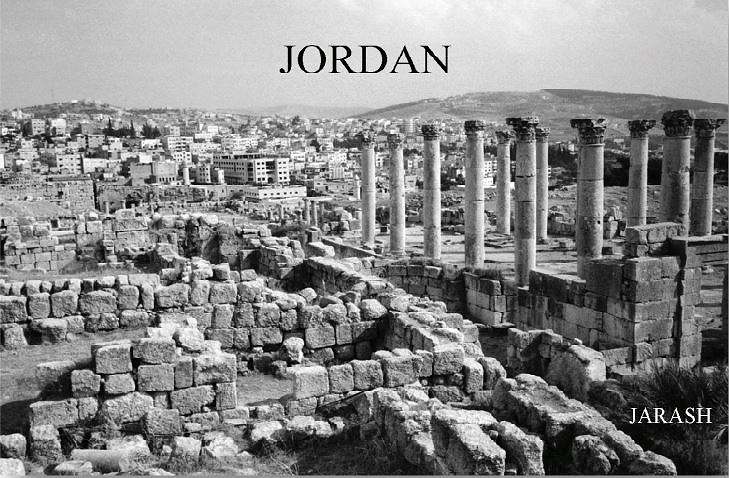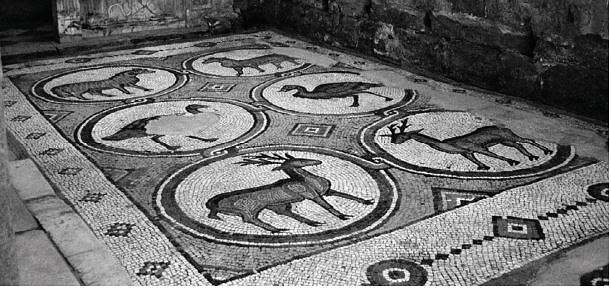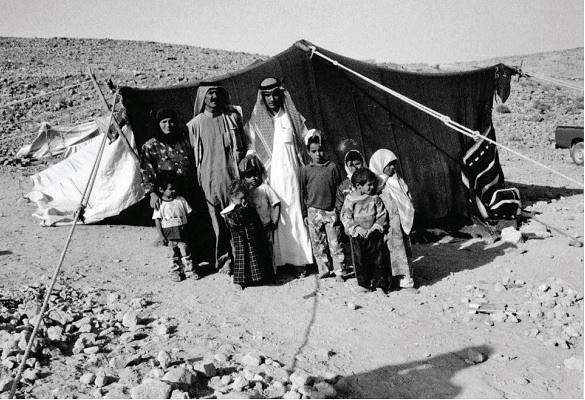
October 2004
Knowing my deep interest in travel, my friend Tom Huckle invited me to join him and his wife Kaye on a trip to Jordan and Egypt. While these countries were not high on my list of undiscovered lands, Tom’s invitation piqued my interest and I decided to follow up with the tour operator, Overseas Adventure Travel. I was the fifteenth person to sign on for a tour that limited the size of the group to sixteen. I had no regrets at this spontaneous decision, despite the trepidations of friends and relatives at my traveling to a part of the world perceived to be unsafe. In fact, the trip was fantastic and exceeded my expectations.
Our tour group congregated at the Egypt Air terminal at New York’s JFK airport. Following the customary waiting period we boarded our nonstop flight of more than 10 hours to Cairo. The flight took off as the pilot prayed over the loud speaker “in the name of Allah, the Merciful, the Compassionate,” as Muslims commonly do before embarking on a major activity. Despite my lack of sleep due to condensed periods between meals — dinner, breakfast, and snacks — this leg of the trip seemed to pass rather quickly.
Eleven of us had signed up for a pre-trip to Jordan, which meant a lengthy wait in transit, as there is only one daily flight between Cairo and Amman, our final destination. Some in our group opted for a sneak preview of the Pyramids, while others preferred to rest at a nearby hotel. We had to turn in our passports to an airport agent, which caused some anxiety on our part. However, we were assured that we would have them back in time for our departure, and we did.
Samer, our local guide, met us at the Queen Alia International Airport in Amman. He then introduced us to our driver and to our tourist police escort, who accompanied us everywhere during our five-day visit to Jordan. A police escort, paid for by the Jordanian government, is provided for all tour groups of more than ten people. The women in our van could not help noticing the handsome features of these dark-skinned Arab men. Later on we found out that Samer was a native of Lebanon and had relocated to Jordan for the job opportunity, which allowed him to support his three children.
Amman, called the “White City” because of its local limestone constructions, is home to 2 million people. It sits on ancient land dating back to the Bronze Age, yet boasts mostly modern buildings, which share the cityscape with antiquities. On our first day, a visit to the Citadel helped us to orient ourselves in the sprawling city down below, while we also gained insight into the Roman, Byzantine, and Islamic dynasties that have occupied these lands. I was struck by a bird’s-eye view of satellite dishes on all the rooftops; TV had certainly become a way of life in contemporary Amman. Water scarcity in this arid land was evident from rooftop water tanks, which people depended on between weekly pumping by the city. Our Citadel walk included the Archeological Museum, which houses the Dead Sea Scrolls, found in 1952 on the western shore of the Dead Sea.
Our next stop was the restored Roman Amphitheatre, built into a hillside downtown. It seats 6000 people and is still used for performances today.
Near the Roman stage we visited the Jordanian Folklore Museum. Guarded by a Circassian statue in traditional dress, it represented a cross section of Jordanian life, from a townhouse to a tent-dwelling Bedouin family. Circassians are Muslims who relocated from the Caucasus to Ottoman lands in the 19th century, in the wake of wars with the Christian tsar in Moscow. Display cases filled with utilitarian items such as bath bowls, ornate brass trays, and rose water containers gave further insight into the daily lives of ethnic peoples. A collection of beautifully colored and embroidered dresses from Jordan and Palestine along with antique jewelry in silver, amber, and coral were among the highlights.
The morning tour concluded with a visit to the Darat el-Funun (House of Art), a contemporary gallery in a restored Ottoman villa.
Jordan became an independent state in 1946 and is one of the most stable Arab countries. The present king, Abdullah, comes from the community of the Hashemites, who rule the country and are believed to be direct descendants of the Prophet Mohammed. 80% of the population have health care coverage. The literacy rate is 89%. Working women and men have equal rights; 20% of women are in the workforce. However, there are not enough jobs for the educated class; many go to the Gulf countries for employment. As we drove through the city, we noticed long lines of men waiting idly for job offers. Our guide identified them as Egyptians willing to do menial work. There are 700,000 Egyptians working in Jordan; many are stone layers at construction sites. In addition, there are 130,000 Palestinians and Lebanese in refugee camps.
In the afternoon we headed to the Dead Sea. As we descended towards this landlocked body of salt water 400 meters below sea level, I had to pop my ears several times along the way. Once there, several of us decided to go for a swim. Actually, we floated rather than swam; the salty water simply lifted my body without any effort on my part. I decided to forgo a plunge into the mud, known for its rich minerals, although those of our group that did go in seemed to enjoy the experience. Calling it a day, we returned to our hotel after stopping at an Arab pastry shop on the way.
The next morning we drove through Amman to head north. As we wended our way through the market, prominent yellow signs caught my eye. These signs marked chicken shops, where one could buy a fresh chicken slaughtered to order on the premises. Other memorable images from my window seat include mounds of olives, apricots, figs, apples, and pomegranates, all locally grown. Jordan is the tenth largest exporter of olives and olive oil in the world. Even olive pits are utilized; since there is no central heating in homes, compacted olive pits are used as fuel. Unlike many other Arab countries, Jordan has no oil.

Mosaic floor in Church of Moses, Mount Nebo
In Anjara we visited the parish of Father Joseph and the college prep school he has established for 500 children. The students were at recess, which gave us the opportunity to speak with them. In the education system, mandatory through tenth grade, boys and girls are divided after primary school. Girls wear headscarves once they reach puberty. Since this was a private school, the students were all learning English and were eager to speak with us. Disciplining of children by a teacher with a stick in hand still seemed to be in practice at this school.
The next town was Ajlun, home to the Saracens’ Castle, built by Saladin in the 12th century. It is a well preserved example of medieval Arab/Islamic architecture with a complex maze of galleries, towers, staircases, and chambers. Saladin defeated the Crusaders and expelled them from Jordan in 1189; the castle was the base from which Islamic forces defended the region against Crusader expansion.
Then we drove to Jarash, one of the ten largest cities in the Eastern Roman Empire. Originally built by Alexander the Great in the 2nd century BC, this city is a well preserved treasure. We saw Hadrian’s Arch, the Nymphaeum, temples to Zeus and Artemis, as well as several theaters and churches. Walking along the colonnaded streets, I kept wondering how the stone columns, weighing tons, might have been erected on top of one another. The expanding vistas of the surrounding rolling hills, as well as the panorama of modern Jarash, contributed to the spectacle of the setting.
Our day ended with dinner at the home of a family in Amman. Our hosts were a low‑income family with four girls and two boys. Dressed in his traditional caftan, the head of the house greeted us at the door, where we left our shoes. Facing our hostess, who wore a long dress and headscarf, we sat on floor cushions along the perimeter of the living room. Following a soup course, we each had a plateful of roasted chicken, pilaf, and sliced tomatoes served from big platters set on a floor covering. For dessert we had fruit — apple and banana — which is a customary way of ending a meal in this part of the world. After dinner we enjoyed mint tea in traditional clear glasses.
We met two of the family’s teenage daughters in the kitchen as we toured the apartment. They had helped cook and were now cleaning up. Like other young women from traditional homes, they wore blue jeans covered by long white tunics, so as not to reveal their body contours. White scarves tightly wrapped around their heads showed only the ovals of their faces. The apartment, which the family owned, was sparsely furnished; the inhabitants slept on floor mats. Through our interpreter we found out that our hostess, who was only 45 years old, had seven grandchildren, the eldest aged thirteen. The family had graciously offered to have us as dinner guests, since our visit was a source of income. The Huckles took Polaroid pictures, which we left as a memento of our visit.
As three of us were riding the elevator back at our hotel, an Italian tourist asked us where we were from. Upon hearing our response, “American,” she turned her back and stopped talking to us. This was the second time that day that I had received a cold shoulder as an American. Earlier in the day when I had approached a young couple for permission to take their picture, the man had responded, “I am an Arab. I don’t speak English.” Fortunately, these instances were few and far between.
Before we departed from Amman, our guide wanted to show us what he called the “Beverly Hills” of the city. Abdoun, where the wealthy live, is a neighborhood of residential palaces with custom-crafted glass front doors and beautiful gardens opening out onto designer sidewalks. 30,000 people from Sri Lanka work as servants in this neighborhood, where it is common for a villa to be cared for by four gardeners. Near this architects’ haven is the US Embassy, a fortress set back from the road and surrounded by local guards in armed tanks.
Curious to see one of the homes, we made an impromptu stop at one under construction. The owner, who was personally supervising the workers, happily gave us a guided tour. Educated in the United States, the man owned 800 hectares of farmland in addition to two factories, which manufactured supplies for drip irrigation. We marveled at the location of his two-story villa, set against the crest of a hill with a stunning view of the surrounding hillside. Buying and selling real estate is a major source of wealth in Jordan. The Koran does not allow payment of interest, but does permit profit of not more than one-third of the original purchase price.

El Kazneh, Petra
Heading south to Petra, we traveled on the King’s Highway, one of the world’s oldest roads for traders, armies, and pilgrims. During the day-long journey along this winding but scenic road, we collected shell fossils, and passed by trees leaning west in search of rain, tree trunks whitewashed with lime to keep insects away, mountainous landscapes where goats grazed on scrappy lumps of grass, and rocky desert terrain. We stopped at the mosaic city of Madaba, an ancient Byzantine town resettled mostly by Greek Orthodox Christians at the end of the 19th century. The mosaic map on the floor of Saint George’s Church is the oldest known map of the Holy Land.
A short distance away, we visited Mount Nebo, believed to be the burial site of Moses. Here early Christians built the Church of Moses, which expanded into a large monastery complex in the 6th century. This complex is rich in mosaics, many featuring animal motifs. From this plateau we began our 3000-foot descent to Wadi Mujib, a dramatic deep gorge mentioned in the Bible as Arnon’s Valley. After emerging through walls of basalt rock, we passed through small villages and a plateau covered in grain. Our scenic landscape varied from shepherds herding their flocks and olive and apple orchards to flat rooftops with laundry lines and plastic bags caught in wire fences. Unfortunately, we missed seeing the black iris, Jordan’s national flower, as it was not in season.
Finally we arrived in Petra, where we spent two nights. Early in the morning our van dropped us off outside the ancient city. We had to choose our own mode of transport to reach the entrance — camel, donkey, horse carriage, or walking. A few of us opted to enter on foot. After walking about a mile, we passed through a narrow passage between 600‑foot-high overhanging sandstone cliffs. As we exited, in front of us glowed El Kazneh (the Treasury), a 140-foot-high edifice carved into a mountain.
Petra is a red-hued city of stone carved by its Nabataean inhabitants some 2000 years ago. It has over 800 elaborate temples, tombs, and houses, as well as a Roman theater carved into the surrounding cliffs. Few of the monuments are free-standing. “Rediscovered” in 1812, ancient Petra was a point of convergence for trade routes and cultural traditions in the Mediterranean basin. Thus, Nabataean architecture is a blend of Hellenistic and Egyptian influences with local Arab/Semitic traditions. Camera in hand, I walked around for several hours admiring the monuments, many of which had eroded into natural striations of white, pink, red, blue, and brown.
Wadi Rum in southeastern Jordan was our next adventure. On the way we stopped to visit a Bedouin family. The Bedouins are a nomadic people who move around with their flocks and tents in search of pasture. Our host family had two tents made of black goat hair; each of the two wives lived in a separate tent with 6 children. We briefly visited the first wife, who was deaf, and then went to the second tent for tea and conversation. There were separate sitting areas within the tent for men and boys on the one hand and for women and girls on the other. A eephole in the room divider allowed men to beckon to the other side for service. Whenever girls came over to the men’s section, where we were being hosted, they were chased back by their brothers as they did not belong there.

A Bedouin family
In the village of Wadi Rum, we switched to 4-wheel-drive vehicles to cross an expanse of desert with pinkish sand. Our Bedouin driver enjoyed speeding along, as we left deep tracks in the Jordanian Sahara. Following Lawrence of Arabia’s footsteps through this sculpted landscape, we came upon petroglyphs in the surrounding cliffs, as well as Nabataean inscriptions. Due to the dry air, the hot desert journey was not uncomfortable. We were careful to use sun protection and to have plenty of drinking water with us. Having thus completed the last leg of our journey, we returned to Amman for our flight back to Cairo.
Jordan is a land I loved to discover. The Middle Eastern food, while somewhat familiar to me, had distinctive local nuances, especially in the use of garlic, spices, and herbs. We ate many fresh vegetables cooked in olive oil, as well as stews served over rice. Chickpeas and eggplant were mainstays. Staples such as yogurt and tahini (a paste made from sesame seeds) appeared at all meals, including breakfast.
Jordan has a rich tradition in crafts, including embroidered cushions, regional pottery, ceramics, mosaics, and glassware, as well as Bedouin jewelry and carpets. Olivewood items and bottles containing various designs made from colored sand are available everywhere, but vary in quality. My favorite purchase in Jordan was a stuffed toy camel for my granddaughter Iris.
